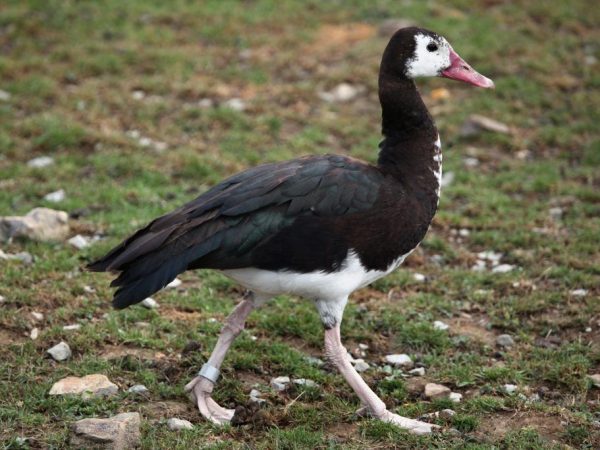Description of the breed of birds clawed goose
Spur goose is the largest member of the duck family. Flocks of clawed geese can be found in Africa on the southern edge of the Sahara Desert. They are also found north of the Zambezi River and in southern Africa. The bird makes nests near water bodies (rivers and swamps), avoids arid places. The clawed goose moves on high legs. Covers distances by running and at the same time is very similar to a stork. Before takeoff, in order to gain speed, the clawed goose runs a long distance and only then takes off from the ground.

Spur goose
Thanks to such characteristics, the clawed goose is able to rule the world of birds, so poachers hunt him constantly. Many hunters and fishermen catch a goose for further resale and consumption. Some farmers try to get a spur representative, but it's not easy to tame him - freedom and a free lifestyle are extremely important for him.
Description of the bird
In a clawed bird, the body length can reach 1 m, a similar representative weighs about 6-8 kg. The male has an unusual and beautiful appearance. The body coat and tail plumage are black-green, the lower part of the belly is white. The bird moves through the air with the help of long black and coal wings. Where the joints are bent, there are so-called spurs, which contain poison. The clawed goose has membranes, thanks to which it quickly forces water. The neck and crown of the bird are painted in dark brown tones. The cheeks are grayish.
There are non-feathered areas on the head, which can be gray, blue or pink. Such a representative has a snow-white graceful neck and an oblong flattened scarlet beak. In females, the red spot, which is located above the beak, is generally less pronounced than in males. The iris of the eye is brown. Females differ from males in size: the male is most often larger than the female. The spur goose usually does not emit sounds characteristic of its family, it is always silent and proud, only a faint whistle is heard from it during the flight.
Behavior
Spur goose prefers a sedentary lifestyle. It is always close to its nest, only if a drought begins, it leaves its usual nesting place. One individual can travel long distances to find a reservoir suitable for breeding. Winged birds build their nest in reeds, on termite mounds, nest in small depressions in the ground near a reservoir.
Sometimes the goose does not wind its house, but occupies suitable holes or empty nests left. Spur geese gather in flocks, which may include no more than 50 individuals. The winged data do not go to contact with other representatives of the duck family. Wildlife hybridization is nearly impossible. Even if you decide to get such a representative to your house or farm, you need to understand that the goose may not get along with other individuals.
Feeding the clawed goose
The bird finds food in water bodies, coastal zones and can eat:
- plant buds;
- young shoots;
- roots.
Also, a representative of the breed feeds on such plant species as comb pond, curly pond, broadleaf cattail, common reed, plantain daisy, finger pig. If you keep a goose at home, it also eats wheat, corn, oats, barley, potatoes, beans, sunflowers and rice. Can dine on beetles, caterpillars, dragonflies and other insects, or have a snack with small fish. When kept on a farm, birds should be regularly released for walks in the fresh air so that they can search for their own food on the ground or near a body of water.
Any type of food or feed must be of high quality and suitable for human consumption. Do not give the birds a rotten mash or dirty cleaning. Water should always be present in the drinkers and be clean. If debris gets into the water, then it must be replaced with fresh one. It is important to follow all the rules for feeding and caring for this type of geese, then it will be possible to grow a bright representative at home.
Breeding geese
At the time of breeding, the bird unites with its partner in a pair, they keep apart from the flock. The male behaves very aggressively with his relatives, animals and birds of other families and species. Sometimes it makes scaring sounds that resemble a cat's hiss. So the individual is trying to secure the clutch. The beginning of the period usually falls on the rainy season. Individuals unite in unions only for the time of incubation of eggs. As soon as the chicks are born, the male leaves the nest. Usually one clutch contains from 8 to 14 eggs. The size of the eggs is about 60 mm, the weight is set around 140 g.
Before leaving the shelter, for example, to find food, the female hides eggs under the fluff. The masonry incubation period is approximately 30 days. After the chicks hatch, the female immediately leaves the nest with the offspring. After about 100 days, her offspring make their first flight. The nest is built by a female, the male does not take part in this. Branches, twigs, stems and leaves become the building material for the nest. When finished, the nest resembles a deep bowl. To provide warmth to the chicks, the female covers the bottom with a thick layer of down and feathers, which she pulls out of her body.


